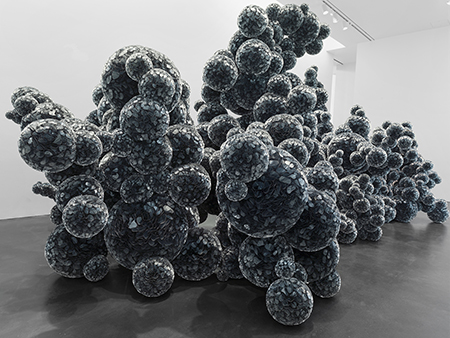
Continuing through January 27, 2019
For anyone encountering Tara Donovan’s work for the first time, the mid-career retrospective “Fieldwork” is simply stunning. It occupies most of the three-floor museum, beckoning visitors into room-size installations that radiate an odd yet powerful beauty. The exhibition is unique in presenting both Donovan’s sprawling assemblages, some of which are site-specific, as well as a similarly impressive sampling of wall-based, studio-made works. In addition, the placement of the works frequently allows for dialogue between two- and three-dimensional variations on a theme. Donovan, a New York artist and 2008 MacArthur Genius grantee, is a leader among the growing number of artists who pour painstaking time and effort into the transformation of unconventional, even mundane materials into unforgettable works. Donovan dedicates herself to labor-intensive, repeated manipulations of objects in order to elevate them to art. “Untitled” is a gathering of nine clustered monoliths erected from thousands of Styrene index cards, glued together in angled stacks that wring curvilinear intrigue out of rectangular ordinariness. The cards could have been throwaways; instead they transform a room into a virtual cave of stalagmites.
“Fieldwork” compels us to linger, to study the wall pieces from different angles to see how they mimic a lenticular image, and to walk around the installations long enough to be immersed in them. They delight the eye both up close and at a distance. There is even a bird’s-eye view from the second floor, where one can look down through an atrium at a small but luminous installation made of stacked gold straws. It’s worth noticing how the monochromatic sculptures can intensify in color from different points of view, how shadows shift across them, and how some sections appear to glisten. There is bound to be oohing and aahing over the sheer size and pleasingly amorphous shapes of the installations, but there is also room for contemplation: Why this particular material? How were so many disparate parts — numbering in the thousands — pieced together? How could something as nondescript as tarpaper sheets be rendered into a tightly layered, dark and dreamlike terrain, as in the site-specific “Transplanted”? Another good example of immersive potential is “Untitled (Mylar)”, a highlight of the second floor. It’s a meditation on micro/macro perspectives, with the micro being the small cones of Mylar pieced into glittery black orbs ranging from fist-size to medicine-ball size. On a macro scale, those orbs gently compress into each other while seeming to clone themselves to fill the room, as if in a growth spurt. Also arresting is how Donovan pays attention to negative space, the nooks and crannies between the balls.
Part of the second floor is devoted to Donovan’s pinboard drawings from 2009-17. Here, she uses thousands of nickel-plated dress pins to form designs on Gatorboard. Despite the humble components, the 11 drawings exuberantly play with density and geometry in ombré patterns. They are in dialogue with the nearby small floor sculptures, 16 in all, made of translucent plastic tubes arranged upright in polygonal shapes, again reinforcing how simple materials can be elevated into aesthetic explorations of light, shadow, form and scale. Nearby is “Untitled (Mylar Tape),” defined as a site-responsive installation because its thousands of small rings of tape — clustered along a wall bathed in natural light, then rounding the corner to another wall — vary in density and pearlescent quality as the day goes on.
In the lower-level portion of “Fieldwork,” a gleeful aspect shines through. “Untitled” is made up of thousands of Slinkys that twist and turn into a freeform sculpture reaching toward the ceiling. The Slinkys shimmer in the light as if in celebration of permanent entanglement. Surrounding the installation are a few of Donovan’s prints experimenting with the concept, as well as a long bas-relief of snaking and interconnected untitled Slinkys. Donovan knows the properties of her materials so thoroughly that even when she flattens the toys they are mesmerizing.
Clearly, Donovan is masterfully exploring the dichotomies between manmade materials and nature’s organic shapes and patterns, creating evocative works that transcend their rudimentary origins. Even if all the “hows” and “whys” that reflexively arise when viewing the works aren’t answered. So much the better.
